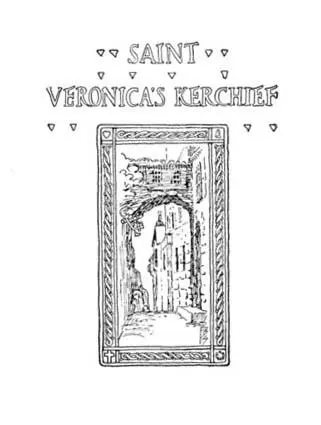Those who came from Jerusalem answered them: “Indeed, we have not seen your son, but in the Temple we saw a most beautiful child! He was like an angel from heaven, and he has passed through Righteousness’ Gate.”
They would gladly have related, very minutely, all about this, but the parents had no time to listen.
When they had walked on a little farther, they met other persons and questioned them.
But those who came from Jerusalem wished to talk only about a most beautiful child who looked as though he had come down from heaven, and who had crossed Paradise Bridge.
They would gladly have stopped and talked about this until late at night, but the man and woman had no time to listen to them, and hurried into the city.
They walked up one street and down another without finding the child. At last they reached the Temple. As they came up to it, the woman said: “Since we are here, let us go in and see what the child is like, which they say has come down from heaven!” They went in and asked where they should find the child.
“Go straight on to where the holy teachers sit with their students. There you will find the child. The old men have seated him in their midst. They question him and he questions them, and they are all amazed at him. But all the people stand below in the Temple court, to catch a glimpse of the one who has raised the Voice of the Prince of this World to his lips.”
The man and the woman made their way through the throng of people, and saw that the child who sat among the wise teachers was their son.
But as soon as the woman recognized the child she began to weep.
And the boy who sat among the wise men heard that some one wept, and he knew that it was his mother. Then he rose and came over to her, and the father and mother took him between them and went from the Temple with him.
But as the mother continued to weep, the child asked: “Why weepest thou? I came to thee as soon as I heard thy voice.”
“Should I not weep?” said the mother. “I believed that thou wert lost to me.”
They went out from the city and darkness came on, and all the while the mother wept.
“Why weepest thou?” asked the child. “I did not know that the day was spent. I thought it was still morning, and I came to thee as soon as I heard thy voice.”
“Should I not weep?” said the mother. “I have sought for thee all day long. I believed that thou wert lost to me.”
They walked the whole night, and the mother wept all the while.
When day began to dawn, the child said: “Why dost thou weep? I have not sought mine own glory, but God has let me perform miracles because He wanted to help the three poor creatures. As soon as I heard thy voice, I came to thee.”
“My son,” replied the mother. “I weep because thou art none the less lost to me. Thou wilt never more belong to me. Henceforth thy life ambition shall be righteousness; thy longing, Paradise; and thy love shall embrace all the poor human beings who people this earth.”

SAINT VERONICA’S KERCHIEF
Table of Contents
I
II
III
IV
V
VI
VII
VIII
IX
Table of Contents
During one of the latter years of Emperor Tiberius’ reign, a poor vine-dresser and his wife came and settled in a solitary hut among the Sabine mountains. They were strangers, and lived in absolute solitude without ever receiving a visit from a human being. But one morning when the laborer opened his door, he found, to his astonishment, that an old woman sat huddled up on the threshold. She was wrapped in a plain gray mantle, and looked very poor. Nevertheless, she impressed him as being so respect-compelling, as she rose and came to meet him, that it made him think of what the legends had to say about goddesses who, in the form of old women, had visited mortals.
“My friend,” said the old woman to the vine-dresser, “you must not wonder that I have slept this night on your threshold. My parents lived in this hut, and here I was born nearly ninety years ago. I expected to find it empty and deserted. I did not know that people still occupied it.”
“I do not wonder that you thought a hut which lies so high up among these desolate hills should stand empty and deserted,” said the vine-dresser. “But my wife and I come from a foreign land, and as poor strangers we have not been able to find a better dwelling-place. But to you, who must be tired and hungry after the long journey, which you at your extreme age have undertaken, it is perhaps more welcome that the hut is occupied by people than by Sabine mountain wolves. You will at least find a bed within to rest on, and a bowl of goats’ milk, and a bread-cake, if you will accept them.”
The old woman smiled a little, but this smile was so fleeting that it could not dispel the expression of deep sorrow which rested upon her countenance.
“I spent my entire youth up here among these mountains,” she said. “I have not yet forgotten the trick of driving a wolf from his lair.”
And she actually looked so strong and vigorous that the laborer didn’t doubt that she still possessed strength enough, despite her great age, to fight with the wild beasts of the forest.
He repeated his invitation, and the old woman stepped into the cottage. She sat down to the frugal meal, and partook of it without hesitancy. Although she seemed to be well satisfied with the fare of coarse bread soaked in goats’ milk, both the man and his wife thought: “Where can this old wanderer come from? She has certainly eaten pheasants served on silver plates oftener than she has drunk goats’ milk from earthen bowls.”
Now and then she raised her eyes from the food and looked around,—as if to try and realize that she was back in the hut. The poor old home with its bare clay walls and its earth floor was certainly not much changed. She pointed out to her hosts that on the walls there were still visible some traces of dogs and deer which her father had sketched there to amuse his little children. And on a shelf, high up, she thought she saw fragments of an earthen dish which she herself had used to measure milk in.
The man and his wife thought to themselves: “It must be true that she was born in this hut, but she has surely had much more to attend to in this life than milking goats and making butter and cheese.”
They observed also that her thoughts were often far away, and that she sighed heavily and anxiously every time she came back to herself.
Finally she rose from the table. She thanked them graciously for the hospitality she had enjoyed, and walked toward the door.
But then it seemed to the vine-dresser that she was pitifully poor and lonely, and he exclaimed: “If I am not mistaken, it was not your intention, when you dragged yourself up here last night, to leave this hut so soon. If you are actually as poor as you seem, it must have been your intention to remain here for the rest of your life. But now you wish to leave because my wife and I have taken possession of the hut.”
The old woman did not deny that he had guessed rightly. “But this hut, which for many years has been deserted, belongs to you as much as to me,” she said. “I have no right to drive you from it.”
“It is still your parents’ hut,” said the laborer, “and you surely have a better right to it than we have. Besides, we are young and you are old; therefore, you shall remain and we will go.”
When the old woman heard this, she was greatly astonished. She turned around on the threshold and stared at the man, as though she had not understood what he meant by his words.
Читать дальше













